© Steve Cary, May 7, 2025
It’s time to round up some recent New Mexico butterfly reports. Yes, butterflying has been slow this spring, with reports down quite a bit from an average year. You all seem to be going out as usual, but finding reduced numbers of butterflies. This is not surprising in these dry times. Rain falls as I write, however, and fingers are crossed that this will bring a prompt at noticeable improvement in butterfly fortunes.
Starting down in our southern borderlands, Gordon Berman says things are “lean” in the Las Cruces area. But he went out anyway and at the summit of Picacho Mountain he found two Black Swallowtails and one Pipevine Swallowtail battling for position. His long view shows very little green other than irrigated fields.
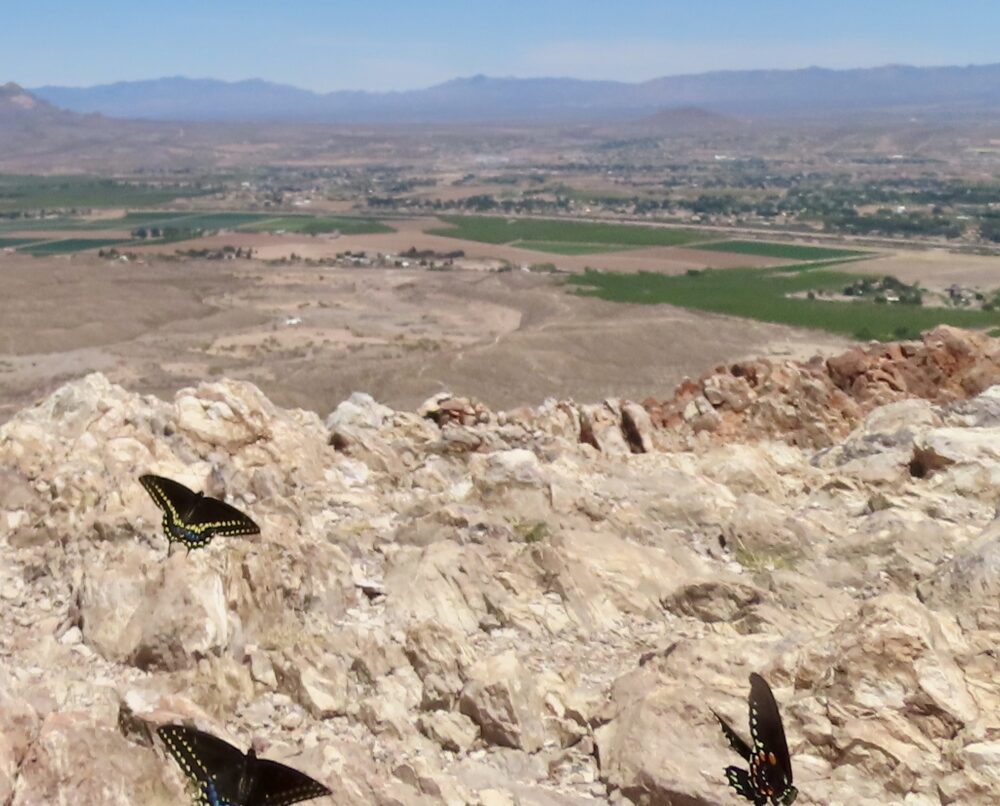
. . . and then from central New Mexico . . .
A Day of New Mexico Butterflying Surprises, by Steven Daniel
“Last fall my wife and I decided to take a trip to New Mexico from upstate New York this spring, I emailed Steve Cary for suggestions on good locations for butterflies. I had read through his book, Butterfly Landscapes of New Mexico, which gave an excellent overview on the habitats and tips for finding species, common and rare, throughout the state. Steve suggested I check the drought conditions, as much of New Mexico was still in a long-term drought. Despite little improvement in winter precipitation over the subsequent months, we decided to come and see whatever we could. Even without butterflies, I knew I’d find the landscapes and botany to be compelling.
Although quite a few New Mexico species would be new to me, a couple of species came to mind right away. The Sandia Hairstreak (Callophrys mcfarlandi) and Arizona Hairstreak (Erora quaderna) could both be flying during the last week in April, when we planned to visit. Steve suggested that both hairstreaks could occur at Cañon de Monte Largo, an infrequently visited canyon in the Manzano Mountains, east of Belen. And he offered to join us; that was an offer I couldn’t refuse!
Our first afternoon in Albuquerque we spent a few hours in Embudito Canyon in the Sandia foothills. Although the morning had been cold, it warmed up by the time we arrived. Three hours of walking and searching in the mid-late afternoon yielded exactly zero butterflies, despite sunny and warm conditions. I suspected that the drought-related lack of nectar plants might be the cause, and our late start could have also contributed.
Steve joined us the next day, April 21. The drive from Albuquerque to the Canon Monte Largo was relatively short and easy, and the unpaved access road to the site, about 11 miles long, was an uncomplicated drive. A higher clearance vehicle helped, but a lower clearance sedan could have made it, though care would be needed in a couple of places. I noticed sacahuista (Nolina sp.) also known as beargrass, along the road when we arrived. Steve suggested we stop and take a closer look. Many plants along the road were flowering or in bud. That boded well, as we learned that the Sandia hairstreak lays its eggs in the flower buds and the larvae feed on the flowers. We searched quite a few plants, and continued to look throughout the day, but, alas, no adults or larvae were found. Hairstreak caterpillars are, for me, always difficult to find, even when they are there.
Since our expectations were low to begin with, based on our time in Embudito Canyon the day before, not seeing Sandia hairstreaks was not a major disappointment. Learning more about its life history and seeing so much of their host plant gave me hope that we still might find it during our week in New Mexico. (Turns out we didn’t.)
But…as we were searching one of the dense flowering spikes of sacahuista, Steve called out “juniper hairstreak.” And it gave us long, excellent, looks. This was a stunning bug, appearing to have just eclosed. Every scale was perfect. This is the subspecies in much of the western US (Callophrys gryneus subsp. siva). We are always happy to see the eastern subspecies (C. gryneus subsp. gryneus), which, I think, is duller orange, compared with the brighter orange- brown scaling on the ventral fw of subsp. siva. In any case, this one was a stunner.

What a start to the day! It was our first New Mexico butterfly of the trip, and Steve’s first New Mexico butterfly of the year.
As we continued up the canyon I noticed a mistletoe growing on one-seeded juniper, which led to a discussion of the chances of seeing a Great Purple Hairstreak, for whom that mistletoe is a host plant. And a short bit later Steve called out that he had one, also nectaring on sacahuista. These butterflies are always a delight to see.
Our excitement didn’t end. A spotted orange and brown butterfly landed on the ground in front of me, which I recognized as a species of metalmark, one of my favorite families of butterflies. It was the spring flying Mexican metalmark.
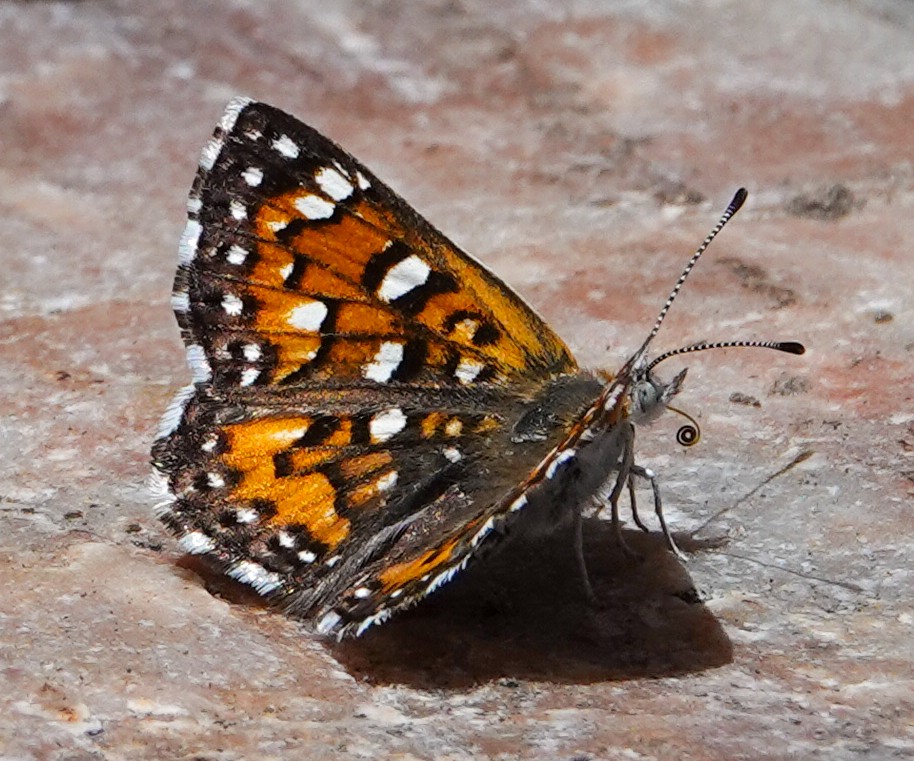
And the butterfly sightings continued – as we made our way up trail, several duskywings (Erynnis) species were patrolling. Duskywings are a troublesome group! We got good looks at the regionally endemic Burgess’ Sleepy as well as the Rocky Mountain Duskywing. A spread-wing skipper with an orange head was nectaring on the yellow-flowering bladderpod (Physaria spp.) This was Steve’s “butterfly of the day” – the Gold-Headed Scallopwing was a new record for Valencia County.
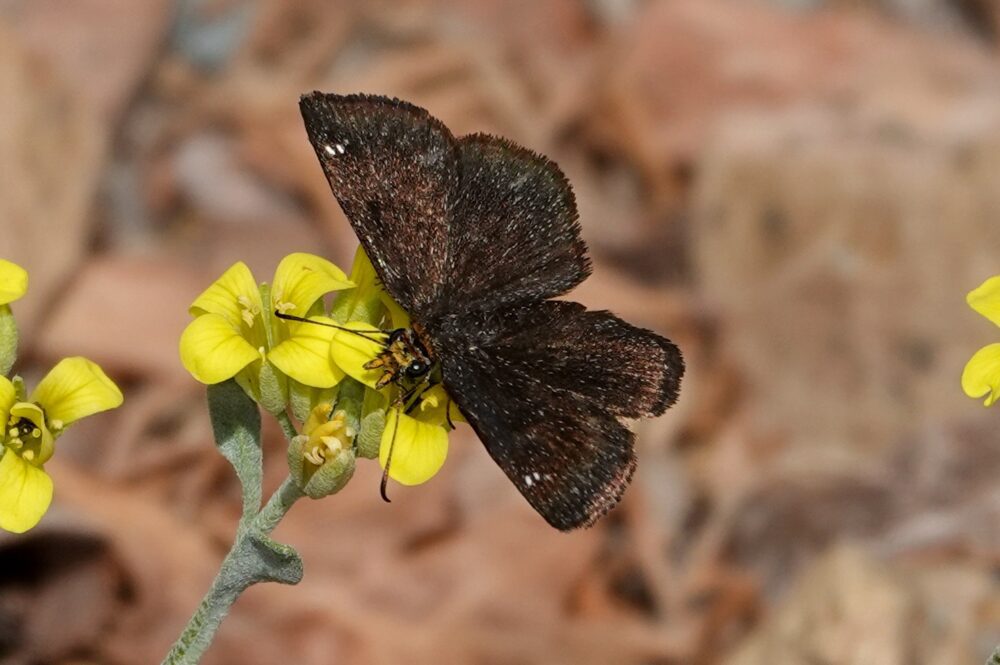
We continued slowly up the canyon looking for a suitable lunch spot. I requested a spot with water, though not really expecting one, as the canyon drainage, to that point, had been dry. I spotted a hairstreak nectaring on Rhus trilobata – but wasn’t sure what it was. As we looked more closely Steve recognized it as the species that drew us to this canyon – the Arizona Hairstreak, Erora quaderna. We didn’t care that it was beat up and missing part of its wing; this was a butterfly I really wanted to see. It was a worn female, showing iridescent blue patches dorsally and the lime green venter. It cooperated for photos and views for quite some time. Readers of this blog may be interested to know that its eastern congener, the Early Hairstreak, Erora laeta, is a grail bug for many of us in the east.
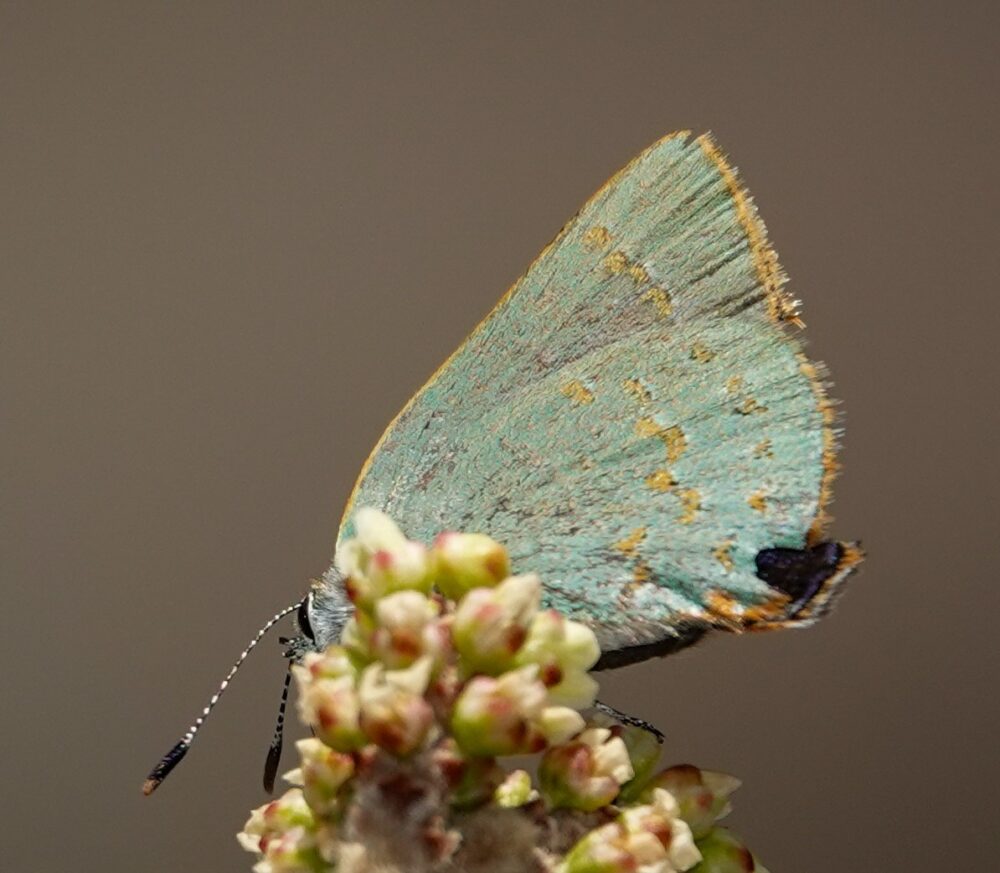
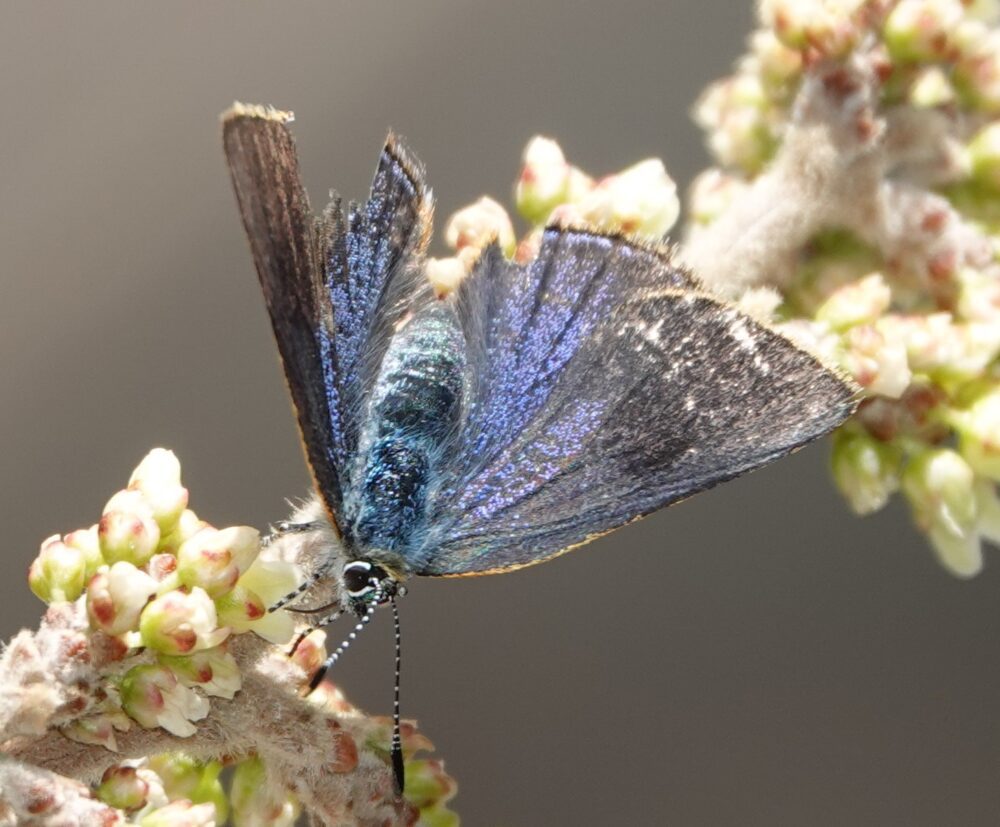
Arizona Hairstreak nectaring at Three-leaf Sumac, photo by Steven Daniel, April 21, 2025.
At this point I was sated – the butterfly outing, was beyond my wildest expectations, which admittedly had been low given the drought and how very few reports there had been to date. All of us were pumped.
And then…we came to …water! Wet mud, and a small puddle, below a trough that collected water from a spring. Butterflies were aplenty: dozens of duskywings, including a couple that Steve thought were Meridian, lots of Short-Tailed Skippers, another Mexican Metalmark, several Echo Azures, and a stunning Two-Tailed Tiger Swallowtail. We could have spent hours at this spot and watch the species composition change. Although we didn’t know it at the time, the USGS topo shows another spring (Upper Monte Largo Spring) a little further up the canyon – next time.
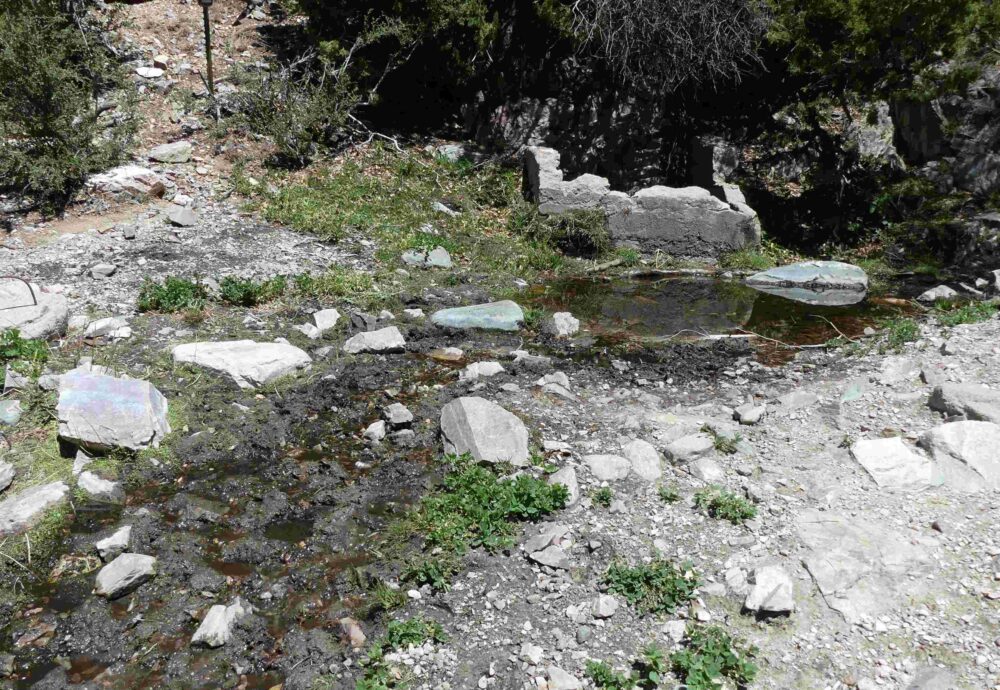
We continued to add species on the walk back, ending the day with a very respectable 17 species. A day that begin with low expectations ended with surprising diversity and many memorable sightings. And I didn’t mention some non-leps of interest, like the blue-eyed darners, nor some interesting plants like the oak-root parasitizing alpine cancer-root.
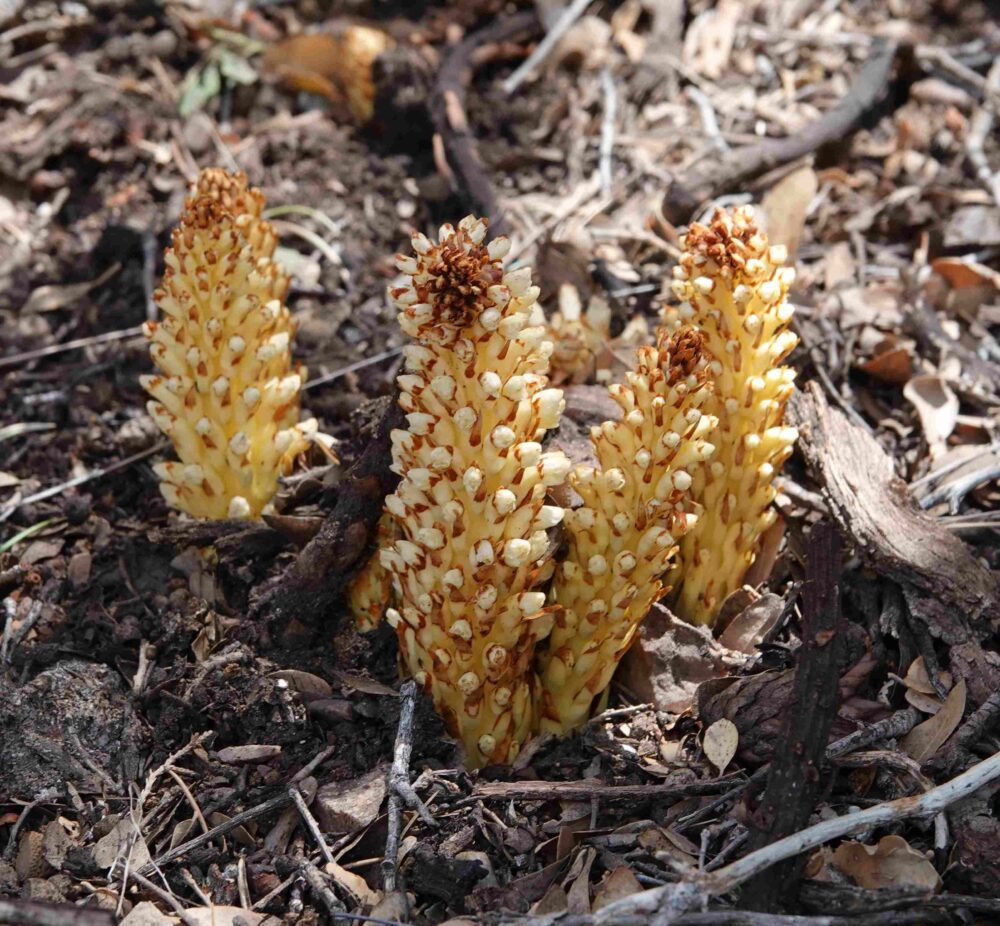

I want to add my appreciations to Steve Cary, for whose blog I am writing this. We would never have found this site nor others we visited in New Mexico, without his guidance based on decades of butterfly study in New Mexico. His generosity in sharing his knowledge as well the friendship that developed in the field greatly added to our New Mexico sojourn.”
[SJC: It was my pleasure, Steven. Thanks for sharing your lovely story, excellent observational skills and stunning images. But just hold on a sec! I think you paint too rosy of a picture. The canyon bottom was completely dry, nectar was very scarce, and 8 of our 17 species were singletons. Except for the duskywings and short-tailed skippers at the one spring-fed mudhole, we struggled to find butterflies the whole time. I say this so butterflyers out there can factor our experiences into their own planning. For more on “the drought” please read the next piece! Possibly just in time for the rains to change everything :^)]
. . . and from our northern mountains . . .
Elfin Explorations by Marc Bailey.
“Hi Steve! I hope you are doing well! Challenging butterfly conditions this spring! I thought I’d share my observations on my trip yesterday [April 24] to Seven Springs in the Jemez checking on my tiny elfin friends. I have visited the same spot in May the past four years and decided to go a little earlier this year. I expected dry conditions but was shocked when I observed a significant die-off of the host plant. My best estimate is 25 – 33% of the numerous kinnikinnic plants in that area have dried up and turned brown (see photo). I had not observed any such brown patches in the previous four years. Sad!
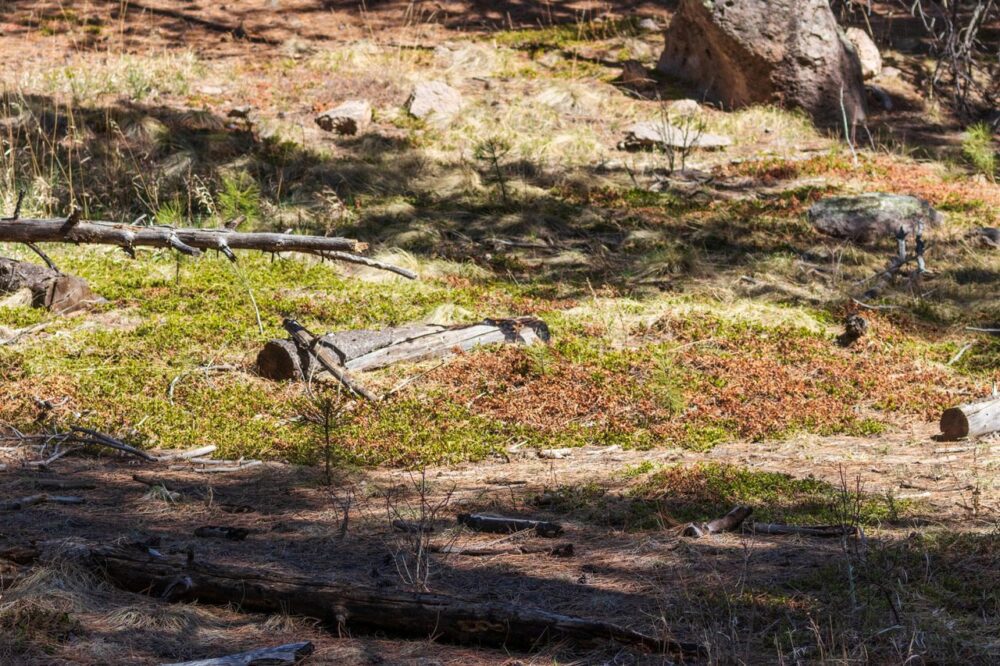
I arrived early in the day for butterflies so hiked a little exploring the area waiting for the temperature to be more favorable. The kinnikinnic was not in bloom yet, and with such dire conditions, I really didn’t expect to find any elfins. But as it warmed up, I started to spot a few (every year, I forget how small they are!). I was drawn to two Hoary individuals that were in a whirling dust devil dance and positioned myself nearby hoping to get a photo. Success! Ever striving for that perfect photo, I stayed put for quite a while and watched the spot where one of them returned to perch. More success, well not perfect, but not bad!
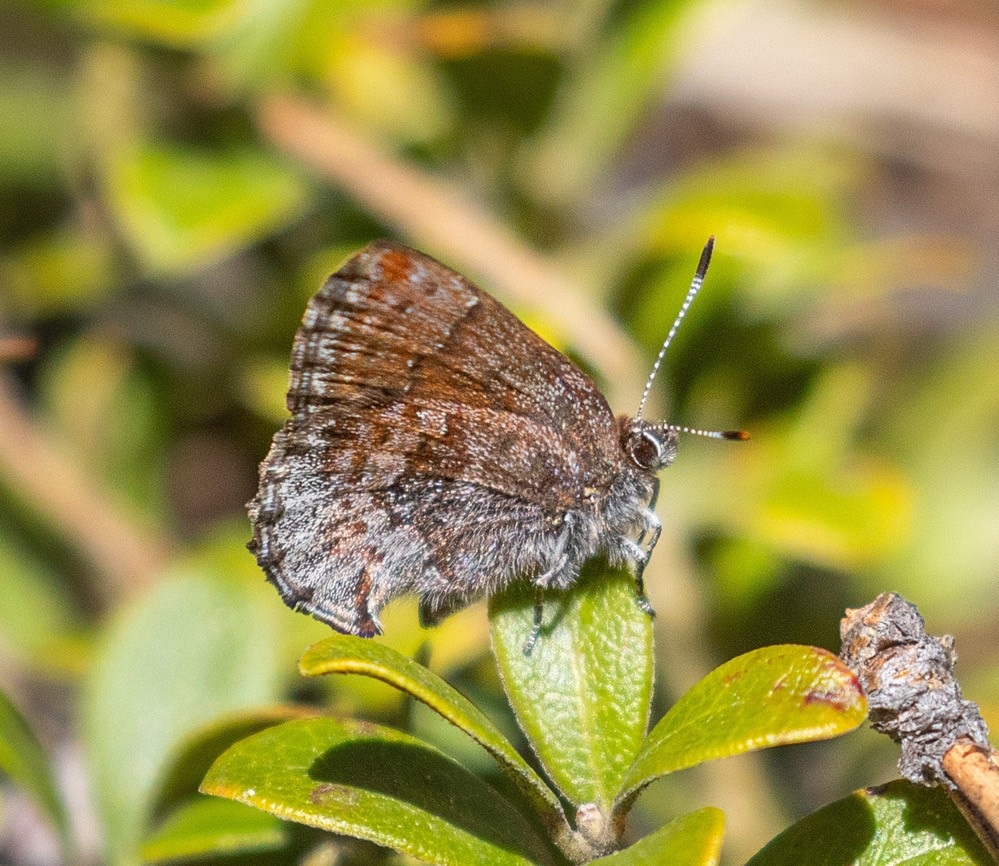
I am amazed how these little guys would go round and round, up and down chasing each other until they both got lower and lower and just “plopped” to the ground close to each other, seemingly exhausted. After a short recharge, they would start in again. Not sure where they are getting their energy! I’ll return in a week or so to see if I can find a Brown Elfin and to determine how observed elfins in this stressful year compare with previous year’s visits. The photo shows how tiny the Hoary Elfin is compared to a kinnickinnic leaf. You can also see a blossom forming in the kinnickinnic. Truly an amazing butterfly!
On May 3, I returned to the elfin location (nine days after my initial visit this year). The forecast called for sunny skies in the morning – a break in a hopefully wet weather pattern for the next several days. It had rained the day before and there were a few welcomed muddy spots in the road as I neared my destination. Climbing the short hill to my observation area I was encouraged to spot two elfins twirling around each other, and then a third individual cruising by a few yards further up. A much better start than my earlier trip! When I reached the top I immediately spotted a single elfin in a patch of green/brown kinnickinnic. Zooming in on the butterfly I saw it was a Brown Elfin, my target species for the day!
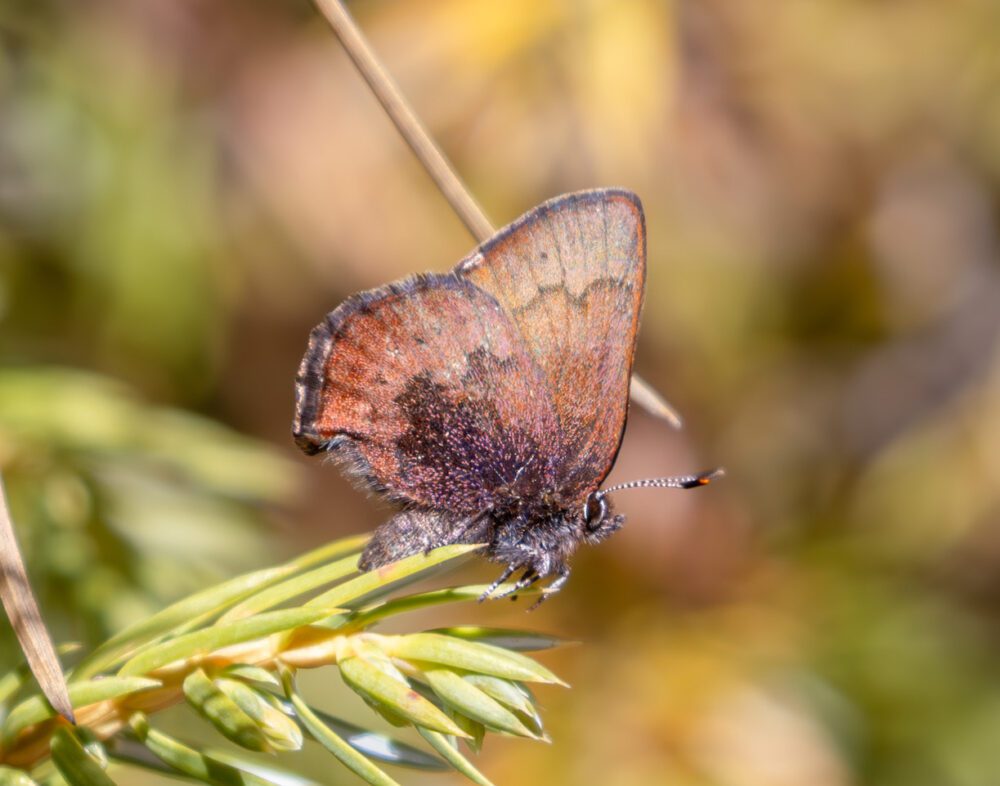
After much cooperation from that one, I continued searching and was pleased to find quite a few elfins flitting about, mostly Hoary but several Brown individuals. As in my visits to this area in previous years, I observed Hoarys out numbering Browns by around 3 to 1. On this day the total number of elfins encountered was equal to or maybe even a little more than the total numbers I saw last year in spite of this year’s alarming die-off of the host plant. I was a little surprised by the lack of flowers on the kinnickinnic on this trip; I remember seeing some flowers on this date last year. I noted that most Brown Elfins I found were around the mixed green/brown patches of kinnikinnick whereas most of the more numerous Hoary Elfins were observed near all green patches. I was also surprised at how the Brown Elfin’s coloration closely matches the dying or dead plants.
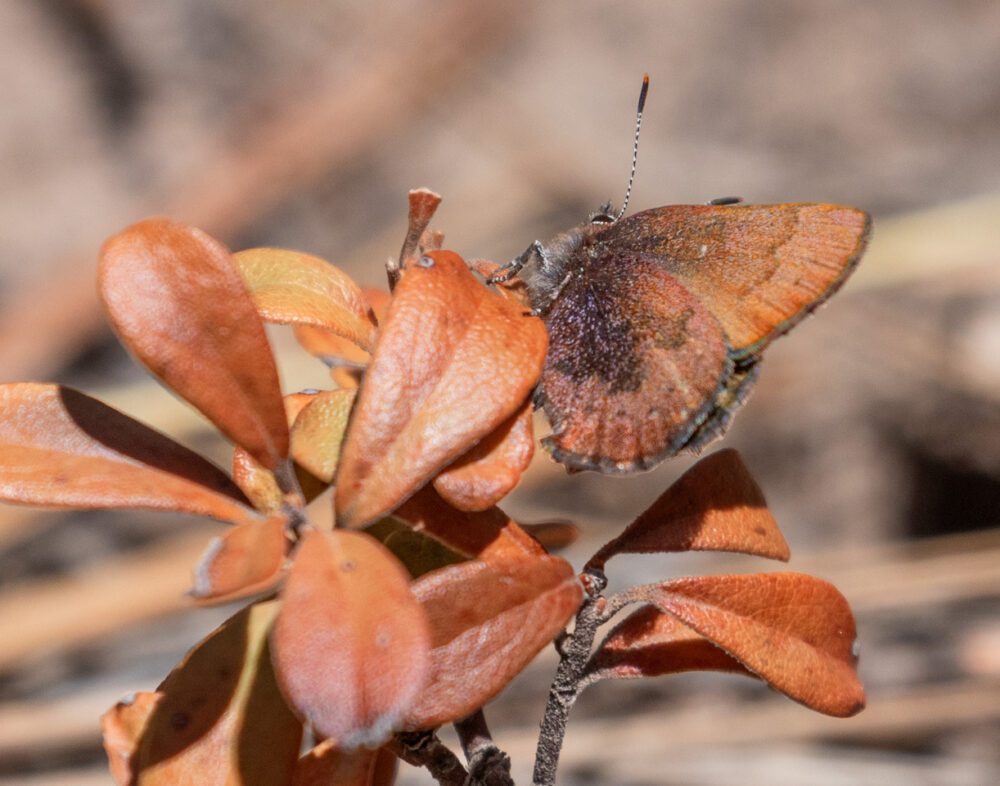
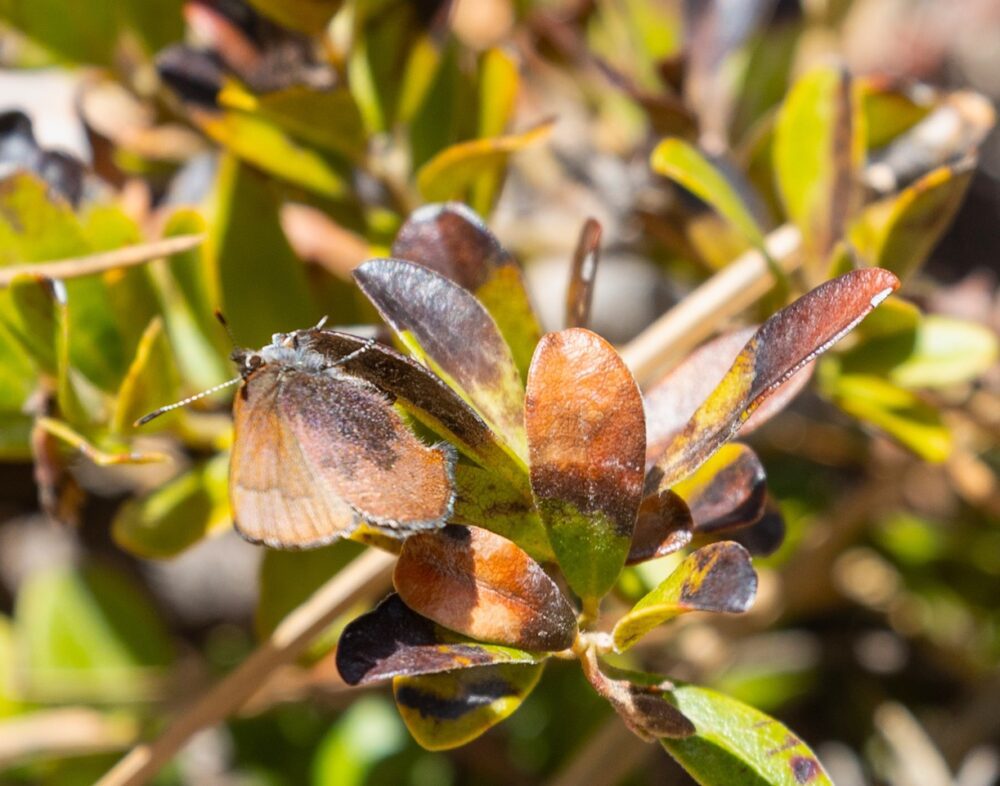
In summary, based on my observations, I don’t believe the observed die-off of the host plant in this area is currently affecting either Hoary or Brown Elfin populations. It will be interesting to see how this year’s conditions might affect the populations there next year. A final note – that area has received significant rainfall the past two days, which is a good thing!”
[SJC: Marc, your terrific observations and photographs are much appreciated. Thanks for sharing! And begging forgiveness of you and readers, one cannot help but wonder exactly how our butterflies and their hosts plants will adapt to the climate changes that are underway. Will patches of dying kinnickinnic lose their Hoary Elfins but keep their Browns? If kinnickinnic is being lost at its current lower elevation boundary, is it expanding at its upper elevation boundary? Your present and ongoing observations may help answer some of these questions.]
April and its experiences, whether good or bad, are now history. The first week of May has brought major changes in weather to at least eastern and northern New Mexico. At my home in Santa Fe, we recorded more than 3 inches of precipitation varying from rain/sleet/snow to hail.
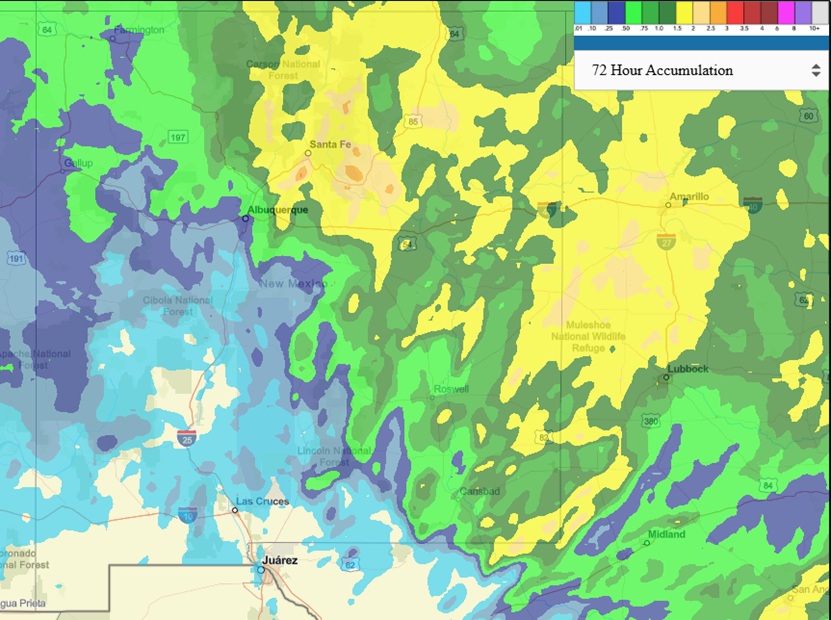
Weather professionals claim (no doubt correctly) that these rains will not compensate for our recent dry winter, but we butterflyers expect that it will bring many flowers into bloom, invigorate larval host plants and stir many butterflies out of diapause and into our viewfinders. Not all of our state has benefited, but butterflyer grimaces may turn to grins over the next few weeks where it has rained. Let the grinning begin!

Once again, a terrific blog! I love Steven Daniel’s post and am so glad that Steve went along and showed him where to find butterflies, even in this sparse butterfly time. Congratulations, Steven, on some terrific sightings and photos!
And the Elfins are wonderful. I wonder if the dead host plants Marc Bailey saw in the Jemez will now somewhat recover after all the snow and rainfall we have had in the past week. I am looking forward to seeing what butterflies finally appear in my yard now that my host plants are starting to have vigorous growth. I have never seen so much rain, snow and large hail in May!
Love this blog. Thanks to both Steven and Mark for sharing their experiences and great pictures. I remember going with Steve to see the elfins near fenton lake some years ago. So glad they are still there.
Couple of great “blooms” I’ve noticed over the last month: Sugarite Canyon’s Opportunity trail has been bustling with Milbert’s Tortoiseshells…more than I’ve ever seen in one place. And at the moment Capulin Volcano’s lower trails are busy with Rocky-Mountain Duskywings: also higher numbers than I’ve seen here before. Other “regular” species do seem to be noticeably reduced or absent. Hopefully things will pick up after the recent rains. The landscape is certainly greening up nicely!
Very cool blog, brother.